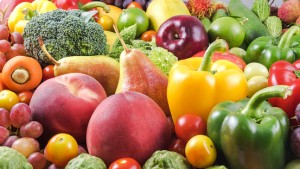Eating more fruits and vegetables helps in weight loss management
 Eating more fruits and non-starchy vegetables can better help you manage weight loss as reported in a recent study. Of course, we know that fruits and vegetables are essential to a healthy diet and overall health, but you may not fully recognize the benefits they have on weight loss management.
Eating more fruits and non-starchy vegetables can better help you manage weight loss as reported in a recent study. Of course, we know that fruits and vegetables are essential to a healthy diet and overall health, but you may not fully recognize the benefits they have on weight loss management.
Fruits and vegetables provide us with essential vitamins and nutrients to ward off illness and maintain a healthy weight. Eating fruits and vegetables is an easy way to achieve a healthy weight because they have minimal calories. To lose weight you need to burn off more calories than you take in. Many people feel the only way to achieve this is by restricting the amount of food we eat, but this isn’t necessarily true. Because fruits and vegetables are low in calories you can enjoy lots of them, and you can add them into your favorite dishes to feel full while still losing weight.
You may also notice that you’re not as hungry when you consume fruits and vegetables because many of them contain water and fiber which keeps you feeling fuller for longer. Essentially, by enjoying more fruits and vegetables you will naturally consume less food: food that could contribute to weight gain.
How eating more fruits and vegetables can help in weight change
 The latest findings suggest eating more fruits and non-starchy vegetables – like soybean and cauliflower – can help you lose weight over the long-term. Additionally, consuming starchy vegetables – potatoes and corn – can actually increase waist size and contribute to weight gain.
The latest findings suggest eating more fruits and non-starchy vegetables – like soybean and cauliflower – can help you lose weight over the long-term. Additionally, consuming starchy vegetables – potatoes and corn – can actually increase waist size and contribute to weight gain.
Researchers noted, “Unfortunately, most Americans have inadequate fruit and vegetable intake,” and when they do consume fruits and vegetables they tend to be starchy or fruit juices which contain high amounts of sugar. Furthermore, the researchers suggested, “Nutritional guidelines ought to emphasize individual or subgroups of specific fruits and vegetables that maximize the potential for weight maintenance and disease prevention.”
Researchers from the Harvard T.H. Chan School of Public Health analyzed 130,000 U.S. adults who were followed for over two decades. Every four years participants mailed in surveys which kept track of their diet on a weekly basis. Weight was also reported every two years.
Researchers found that those who consumed more fruits and non-starchy vegetables over a four year period lost more weight compared to those who did not. For each additional serving of fruit, participants lost half a pound, and an additional serving of vegetables resulted in weight loss of a quarter of a pound. Researchers found those who ate more fruits and vegetables also consumed less unhealthy foods. Findings also uncovered that replacing five percent of calories with fruits and vegetables over the course of four years was associated with one pound of weight loss.
Fruits most beneficial for weight loss were berries, apples and pears. Cauliflower and soybeans were also deemed essential for smaller waistlines. Starchy vegetables, on the other hand, were associated with two pounds of weight gain over four years with each additional serving.
Starchy vegetables are not as beneficial for weight loss because they increase blood sugar which can explain the added weight. Spikes in blood sugar can contribute to hunger cravings which lead people to eat more.
Fruits and vegetables with higher fiber content promote feelings of fullness which reduce appetite.
The study was primarily done on Caucasian adults with high levels of education, so it’s hard to know for certain if the results could apply to the general population. As far as we do know, fruits and vegetables are still essential for overall good health.
List of non-starchy vegetables useful for weight management
 If you’re unsure as to which vegetables are non-starchy, here is a list to follow.
If you’re unsure as to which vegetables are non-starchy, here is a list to follow.
- Amaranth or Chinese spinach
- Artichoke
- Artichoke hearts
- Asparagus
- Baby corn
- Bamboo shoots
- Beans (green, wax, Italian)
- Bean sprouts
- Beets
- Brussels sprouts
- Broccoli
- Cabbage (green, bok choy, Chinese)
- Carrots
- Cauliflower
- Celery
- Chayote
- Coleslaw (packaged, no dressing)
- Cucumber
- Daikon
- Eggplant
- Greens (collard, kale, mustard, turnip)
- Hearts of palm
- Jicama
- Kohlrabi
- Leeks
- Mushrooms
- Okra
- Onions
- Pea pods
- Peppers
- Radishes
- Rutabaga
- Salad greens (chicory, endive, escarole, lettuce, romaine, spinach, arugula, radicchio, watercress)
- Sprouts
- Squash (cushaw, summer, crookneck, spaghetti, zucchini)
- Sugar snap peas
- Swiss chard
- Tomato
- Turnips
- Water chestnuts
- Yard-long beans
List of weight loss friendly fruits
 On the same theme, below is a list of weight loss-friendly fruits.
On the same theme, below is a list of weight loss-friendly fruits.
- Berries
- Melons
- Apples
- Pears
- Peaches
- Plums
- Coconuts
- Avocados
- Bananas
- Plantains
- Strawberries
How to eat more fruits and vegetables throughout the day
It may be tricky at first to incorporate more fruits and vegetables into your diet, but with these easy tricks you can start eating more fruits and vegetables and receive their weight loss benefits.
- Sneak them into meals, like in sauces, meatloaf’s or desserts
- Dip fruits and vegetables into hummus or low-fat yogurt
- Try cooking them if you don’t enjoy them in raw form
- Ask for help if you think they take too long to prepare and cook
- Eat the majority of your fruit and vegetable servings in the morning so you don’t have to worry about them later on
- Blend them into a smoothie – this can mask the taste of some of your not-so-favorite options
- Try a variety of fruits and vegetables – if you don’t like some fruits and vegetables be open to try other options to find one you do enjoy
- Set a daily goal of fruits and vegetables you want to eat in the day
- Replace unhealthy snacks with easy to carry around fruits and vegetables like bananas or apples – even carrot sticks are easy to bring around with you
- Add more fruits and vegetables into your favorite dish
- Make substitutions – instead of spaghetti use spaghetti squash, or instead of pizza dough make a cauliflower pizza crust
You can get creative with how you incorporate more fruits and vegetables into your diet; the trick at first is to simply be mindful. Better yet, fruits and vegetables can actually enhance the flavor of many dishes, so you may actually begin to enjoy them once more.
With all the health benefits, including weight loss, associated with fruits and vegetables you should definitely make it your goal to consume more.
Easy tips to eat more fruits and vegetables
You know the drill: Eat more fruits and vegetables! Time and time again you’re told to stock up on your fruits and vegetables, but sometimes it’s just so hard to get in the recommended amount. Continue reading…
-
Ways To Attain Your Perfect Body Weight
There are many people who are becoming self-conscious when it co
-
Weight Loss Basics -- A Scientific Prospective
In order to achieve weight loss calorie
-
Diets Don’t Work!
Many of you have heard me and many others say Diets DON’T WOR
-
Ready, Set, In Compliance
The Federal Reserve Bank recently updated its Cash Services Operating
-
800lb Woman Stands Up For The First Time
Marla hasn’t stepped on a scale in five years but
-
Is Emotional Overeating Weighing You Down?
Are you: * eating when you aren’t really hungry? * struggling
- DON'T MISS
- Ultimate Weight Loss Ephedra Is Back
- Best Weight Loss Tips - Weight Loss Secrets
- What Is The Most Natural Way To Lose Weight And Keep It Off?
- Another Possibility To Lose Weight
- Curried Lentil Soup
- 5 Key Reasons Why Fad Diets Fail, and 5 Proven Alternatives to Help You Lose Weight Easily, Naturally, and Permanently
- About Stamina Pilates Machines
- Raw Food Diet Plan For A Healthier Body
- Building Muscle Without Weights
- Gastric Bypass Complication Gastrogastric Fistula




